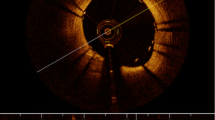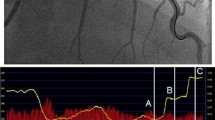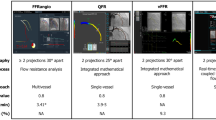Abstract
Fractional flow reserve (FFR) and intravascular imaging respectively provide hemodynamic and anatomical assessments of angiographic intermediate stenoses. Frequency domain optical coherence tomography (FD-OCT) is a promising high-resolution imaging modality, but its clinical use in determining severity of coronary disease has yet to be determined. There, we set out to determine the role of FD-OCT to complement FFR in the evaluation of intermediate coronary artery stenoses. FD-OCT was planned in 176 consecutive interventional procedures at our institution to delineate the proper use of FD-OCT in clinical practice. The decision to use other invasive assessments was at the discretion of the operator. This report describes an early series of the 14 patients who underwent FFR of 18 target stenoses in addition to FD-OCT. FD-OCT was successfully performed without complications in all cases. Fractional flow reserve was <0.80 in four patients, with minimal lumen areas and reference vessel diameters ranging from 1.03 to 3.47 mm2 and 2.60 to 2.94 mm by FD-OCT, respectively. FD-OCT was important to rule out plaque rupture, erosion and thrombosis and to help guide decision to defer PCI in six patients with acute coronary syndrome and FFR > 0.80. FD-OCT was also valuable to guide PCI strategy in tandem lesions with an FFR < 0.80. This initial experience with FD-OCT suggests a potential complementary role of physiological and anatomical assessment to guide decision making in complex clinical scenarios. Future investigations are warranted to validate these findings and define the role of FD-OCT in assessing intermediate lesions.


Similar content being viewed by others
Abbreviations
- FFR:
-
Fractional flow reserve
- IVUS:
-
Intravascular ultrasound
- FD-OCT:
-
Frequency domain optical coherence tomography
- UH-CMC:
-
University hospitals case medical center
- FDA:
-
United States food and drug administration
- IRB:
-
Institutional review board
- PCI:
-
Percutaneous intervention
- PSI:
-
Pounds per square inch
- QCA:
-
Quantitative coronary angiography
- HTN:
-
Hypertension
- DM:
-
Diabetes
- DLD:
-
Dyslipidemia
- PAD:
-
Peripheral arterial disease
- MI:
-
Myocardial infarction
- CVA:
-
Cerebrovascular accident
- CABG:
-
Coronary bypass surgery
- UA:
-
Unstable angina
- NSTEMI:
-
Non-ST segment myocardial infarction
- STEMI:
-
ST-segment elevation myocardial infarction
- LAD:
-
Left anterior descending coronary artery
- LCx:
-
Left circumflex coronary artery
- RCA:
-
Right coronary artery
- LM:
-
Left main coronary
- RLA:
-
Reference vessel luminal area (mm2)
- mRLA:
-
Mean reference vessel luminal area (mm2)
- MLA:
-
Minimal luminal area (mm2)
- AS:
-
Area stenosis (%)
- RLD:
-
Reference vessel luminal diameter (mm)
- mRLD:
-
Mean reference vessel luminal diameter (mm)
- MLD:
-
Minimal lumen diameter (mm)
- DS:
-
Diameter stenosis (%) lesion length (in mm)
References
Pijls NH, van Schaardenburgh P, Manoharan G et al (2007) Percutaneous coronary intervention of functionally nonsignificant stenosis: 5-year follow-up of the DEFER study. J Am Coll Cardiol 49:2105–2111
Tonino PA, De Bruyne B, Pijls NH, on behalf of FAME Study Investigators et al (2009) Fractional flow reserve versus angiography for guiding percutaneous coronary intervention. N Engl J Med 360:213–224
Costa MA, Sabate M, Staico R et al. (2007) Anatomical and physiologic assessments in patients with small coronary artery disease: final results of the physiologic and anatomical evaluation prior to and after stent implantation in small coronary vessels (PHANTOM) trial. Am Heart J 153:296.e1–7
Abizaid AS, Mintz GS, Mehran R et al (1999) Long-term follow-up after percutaneous transluminal coronary angioplasty was not performed based on intravascular ultrasound findings: Importance of lumen dimensions. Circulation 100:256–261
Briguori C, Anzuini A, Airoldi F et al (2001) Intravascular ultrasound criteria for the assessment of the functional significance of intermediate coronary artery stenoses and comparison with fractional flow reserve. Am J Cardiol 87:136–141
Nam CW, Yoon HJ, Cho YK et al (2010) Outcomes of percutaneous coronary intervention in intermediate coronary artery disease: fractional flow reserve-guided versus intravascular ultrasound-guided. J Am Coll Cardiol Intv 3:812–817
Bezerra HG, Costa MA, Guagliumi G, Rollins AM, Simon DI (2009) Intracoronary optical coherence tomography: a comprehensive review. J Am Coll Cardiol Intv 2:1035–1046
Tahara S, Bezerra HG, Baibars M et al (2011) In vitro validation of new fourier-domain optical coherence tomography. Eurointervention 6:875–882
The Principal Investigators of CASS and Associates (1981) The National Heart, Lung and Blood Institute Coronary Artery Surgery Study (CASS). Circulation 63(Suppl I):1–81
Ellis SG, Vandormael MG, Cowley MJ et al (1990) Multivessel angioplasty prognosis study group. Coronary morphologic and clinical determinants of procedural outcome with angioplasty for multivessel coronary disease. Implications for patient selection. Circulation 82:1193–1202
Takagi A, Tsurumi Y, Ishii Y et al (1999) Clinical potential of intravascular ultrasound for physiological assessment of coronary stenosis: relationship between quantitative ultrasound tomography and pressure-derived fractional flow reserve. Circulation 100:250–255
Jasti V, Ivan E, Yalamanchili V, Wongpraparut N, Leesar MA (2004) Correlations between fractional flow reserve and intravascular ultrasound in patients with an ambiguous left main coronary artery stenosis. Circulation 110:2831–2836
Yamaguchi T, Terashima M, Akasaka T et al (2008) Safety and feasibility of an intravascular optical coherence tomography image wire system in the clinical setting. Am J Cardiol 101:562–567
Suzuki Y, Ikeno F, Koizumi T et al (2008) In vivo comparison between optical coherence tomography and intravascular ultrasound for detecting small degrees of in-stent neointima after stent implantation. J Am Coll Cardiol Intv 1:168–173
Gonzalo N, Serruys PW, García-García HM et al (2009) Quantitative ex vivo and in vivo comparison of lumen dimensions measured by optical coherence tomography and intravascular ultrasound in human coronary arteries. Rev Esp Cardiol 62:615–624
Blows LJ, Redwood SR (2007) The pressure wire in practice. Heart 93(4):419–422
Pijls NH, de Bruyne B, Bech JW et al (2000) Coronary pressure measurement to assess the hemodynamic significance of serial stenoses within one coronary artery. Validation in humans. Circulation 102:2371–2377
Kubo T, Imanishi T, Takarada S et al (2007) Assessment of culprit lesion morphology in acute myocardial infarction: ability of optical coherence tomography compared with intravascular ultrasound and coronary angioscopy. J Am Coll Cardiol 50:933–939
Kern MJ, Samady H (2010) Current concepts of integrated coronary physiology in the catheterization laboratory. J Am Coll Cardiol 55:173–185
Author information
Authors and Affiliations
Corresponding author
Rights and permissions
About this article
Cite this article
Stefano, G.T., Bezerra, H.G., Attizzani, G. et al. Utilization of frequency domain optical coherence tomography and fractional flow reserve to assess intermediate coronary artery stenoses: conciliating anatomic and physiologic information. Int J Cardiovasc Imaging 27, 299–308 (2011). https://doi.org/10.1007/s10554-011-9847-9
Received:
Accepted:
Published:
Issue Date:
DOI: https://doi.org/10.1007/s10554-011-9847-9




